Leading Trans Litigator Debates Andrew Sullivan about pediatric gender medicine, and I respond
Shannon Minter, legal director at the National Center for LGBTQ Rights, held a spirited debate about pediatric gender medicine with Sullivan on his podcast. Then I gave critiques of their arguments.

Last week, I was delighted to discover that a leading legal advocate in the transgender-rights arena had gone on
’s podcast, , to perform the unthinkable: engage in a civilized, spirited debate across the aisle about gender-transition treatment for minors.Shannon Minter, a transgender man, is the longtime legal director at the National Center for LGBTQ Rights and has been a pivotal figure in litigation to protect minors’ access to puberty blockers, cross-sex hormones and gender-transition surgeries to treat gender dysphoria.
Andrew Sullivan, a veteran conservative journalist and a gay man, recently published a mammoth opinion essay in The New York Times arguing that the LGBTQ advocacy movement had gone radically off the rails, in particular by devoting much of its energy to the medical transitions of children.
He wrote:
The gay rights movement, especially in the marriage years, had long asked for simple liberal equality and mutual respect — live and let live. Reform, not revolution. No one’s straight marriage would change if gay marriage arrived, we pledged. You can bring up your children however you like. We will leave you alone. We will leave your children alone.
But in the wake of victory, L.G.B.T.Q. groups reneged on that pledge. They demanded that the entire society change in a fundamental way so that the sex binary no longer counted. Elementary school children were taught that being a boy or a girl might not have anything to do with their bodies and that their parents had merely guessed whether they were a boy or a girl when they were born. In fact, sex was no longer to be recognized at birth — it was now merely assigned, penciled in. We got new terms like “chest-feeding” for “breastfeeding” and “birthing parent” for “mother."
The ACLU’s Chase Strangio, for one, has preferred to take shots at Mr. Sullivan from afar. He recently sat for a 2-hour podcast with queer influencer Matt Bernstein, of the signature press-on fingernails, in which Messrs. Strangio and Bernstein went through every line of Mr. Sullivan’s editorial and lavished his words with scorn.
So it’s not a given these days that anyone sitting in one camp on the issue of pediatric gender medicine would agree to speak in a public forum to someone from another faction, given how inhospitable the climate can be toward associated civil debate.
During the early years of the decade, a series of major articles about gender transitions for minors were published that caused advocates in this field to begin stonewalling mainstream journalists. This included, in particular,
’s Oct. 2021 article in what is now ’s in which she quoted the transgender psychologist Erica Anderson criticizing the field of pediatric gender medicine as providing “sloppy care”. Then came Emily Bazelon’s superb exploration of the battles over the direction of this medical field in The New York Times Magazine in June 2022. I recently listened to a podcast recorded in the immediate aftermath of that article’s publication in which trans historian Jules Gill-Peterson concocted the most fancifully wild accusations of Ms. Bazelon’s supposedly invidious intent behind writing the article. Dr. Gill-Peterson made abundantly clear in her lengthy rants that, as she saw it, trans advocates spoke to mainstream journalists at their peril.After Ms. Shrier published her piece, leaders at USPATH, the U.S. branch of the medical-activist group the World Professional Association for Transgender Health (WPATH), revolted against Dr. Anderson, who was then the USPATH president. Against Dr. Anderson’s strong objections, the organization ultimately imposed a moratorium on its experts talking to the press. Dr. Anderson warned that this would only backfire.
Dr. Anderson has since been vindicated. The absence of voices from trans advocates in mainstream media articles, including my own, only impoverishes the public’s understanding of this complex and combustible issue and serves to further divide the factions and entrench them in their disagreements. I for one have been subjected to widespread blacklisting not only when I cover transgender issues, but also when covering HIV, which I have been doing for a quarter century.
How Cancel Culture Is Still Coming For Me
Some people think that in this supposedly post-woke era, cancel culture, at least from the left, has come to a close.
So I am impressed that Mr. Minter sought to go against the grain and subject himself to some pretty pointed grilling on Mr. Sullivan’s part. I highly recommend listening to the podcast, which illustrates the powerful disagreement members of the wider LGBTQ community hold over the wisdom of medically transitioning children. The podcast further demonstrates how personal experience—transitioning as an adult on Mr. Minter’s part and experiencing childhood gender-related ambivalence on Mr. Sullivan’s part before he grew into a gay man—often guides perceptions of the issue.
After listening to the podcast, I texted a few thoughts to Mr. Sullivan, who asked that I email him and Mr. Minter so we could continue the conversation. Mr. Sullivan just published that exchange on his Substack; I’m republishing it below.
From Andrew Sullivan’s Substack
Andrew Sullivan:
The meticulous journalist, Ben Ryan, who covers this issue on his substack and elsewhere, texted me, so I invited him to write a response here, and have Shannon respond. In trying to get into the nitty gritty, it’s helpful.
Ben Ryan:
Dear Shannon and Andrew,
Thanks for an enlivening Dishcast episode. I’m really glad that the two of you came together to have some healthy debate, disagreement and discussion. I wanted to email a few thoughts in response to some of your disagreements. Overall, I think that Shannon might benefit from a bit clearer understanding of the science. But I also think that Andrew sometimes overgeneralizes and expresses more confidence in what we know from the science than what the often very hazy research can say at this point.
Shannon, I appreciate that you were willing to go on Andrew’s show in the first place. It has become very rare that advocates in your corner are willing to be subjected to tough questioning on this issue.
This isn’t a comprehensive list, but I took a few notes of questions as I was listening:
Did Cass recommend a ban?
Hilary Cass recommended that puberty blockers be prescribed for gender dysphoria within a research program. She originally recommended the establishment of such a program in 2022. In the Cass Review, published in April 2024, she recommended:
The evidence base underpinning medical and non-medical interventions in this clinical area must be improved. Following our earlier recommendation to establish a puberty blocker trial, which has been taken forward by NHS England, we further recommend a full programme of research be established. This should look at the characteristics, interventions and outcomes of every young person presenting to the NHS gender services.
The NHS took this recommendation and applied a ban on its doctors prescribing blockers outside of a planned clinical trial. The trial was supposed to start early this year, but is still held up in the regulatory and ethics approval process. The NHS just announced the launch of an observational study of minors attending its new system for caring for minors with gender dysphoria. The puberty blocker study will be an outgrowth of that study.
Cass also advised that doctors should observe extreme caution when prescribing cross-sex hormones (CSHs) to 16 and 17 year olds, which under current NHS policy they still can. (Prescriptions for CSHs are barred for minors under 16.) But Wes Streeting, the UK health commissioner, is considering banning such prescriptions. Parliament, under the departing conservative government, applied an emergency ban on private doctors prescribing blockers, one that the Labour government made permanent.
Did Cass say gender-transition treatment improves mental health outcomes?
It’s important to avoid causal language when discussing these treatments. No one has ever proved that they cause certain outcomes. Studies have shown that the medications are associated with certain outcomes, such as lower depression, anxiety and suicidality.
Cass certainly acknowledged all of this. But she also referred to the systematic literature reviews she commissioned from the University of York that concluded, regarding cross-sex hormones:
There is a lack of high-quality research assessing the use of hormones in adolescents experiencing gender dysphoria/incongruence. Moderate-quality evidence suggests mental health may be improved during treatment, but robust study is still required. For other outcomes, no conclusions can be drawn.
Above all, Cass said that this research field is supported by “remarkably weak evidence.” So while she did say that these treatments might be right for some youth, she most importantly said we can’t say this with any confidence.
It’s important to consider that gender-transition treatment, apart from any lobotomies performed on minors during the mid-20th century, represents the only time in US medical history that doctors have sought to change children’s bodies to treat their minds. This demands a higher level of certainty about prescribing these treatments to the right children — the ones for whom the considerable potential risks (e.g.: loss of fertility, loss of ability to breastfeed) are reasonable to undertake given the potential benefits. In no other circumstance would doctors agree to provide a treatment to a child that would or could end their fertility absent a condition that would otherwise be fatal. Gender dysphoria is not a certifiably fatal condition, as much as many advocates routinely suggest that it is.
I can speak personally to this as an adult, having had testicular cancer. I had an orchiectomy; and later, after a recurrence, I had to undergo fertility preservation in advance of having chemotherapy. I was 43 at the time and did not want children. But I knew that I was still too young to close the door on the possibility of having children. How can a child who starts blockers at age 9 to 13 make such a decision, especially when the child is incapable of providing a sperm sample in the first place?
That said, children who start gender-transition drugs in Tanner 2 (i.e.: the first stage of puberty) are in the distinct minority. The typical child who starts such drugs is a natal girl who is about 13 to 16 years old. See my post on Substack, based on this article on JAMA Pediatrics published on January 6, which includes this chart:
Research suggests that natal females often maintain their fertility after long-term testosterone use. But there are no guarantees; more research is needed.
Did Boston Children’s Hospital (BHC) provide blockers after two hours?
Court testimony heard last fall from multiple current and former leading clinic staffers revealed that since 2018, it has been BCH’s policy to provide minors seeking blockers or hormones for gender dysphoria a single two-hour assessment appointment with a psychologist before BCH decides whether they should be referred to endocrinology. You can listen to the testimony here.
The Boston Globe later ran an article that seemed to challenge this finding. But the truth is more nuanced than people such as the debunking podcaster Michael Hobbes have claimed. The Globe reported that for children who start treatment for gender dysphoria pre-puberty, they often are seen by mental health professionals for a long period at BCH before they come to the point where they seek blockers or hormones. But as Amy Tishelman, a former psychologist at BCH, said in the article, this scenario does not describe the typical child who goes to the BHC gender clinic. Typically, children arrive at the clinic after having started puberty and are eagerly seeking medications. It is those kids who, as a matter of policy, can and do get whisked through the assessment system after the single two-hour appointment.
Dr. Tishelman testified in court that she did not think this assessment time was sufficient; she called it “reckless.” Former BCH psychologist Laura Edwards-Leeper told me that she found the policy “shocking.” But BCH staffers defended it in court, saying the time was sufficient. Nevertheless, one of them admitted that the time was shaved down from 10 to two hours for financial reasons.
Ask yourself, however: If BCH, which is considered one of the finest children’s hospitals in the world, was so confident about this policy, why did they keep it secret for nearly seven years? Why did it take an employment-discrimination lawsuit to have the policy come to light?
Do kids get rapidly put on blockers and hormones?
There is a lot of evidence that a substantial number of clinics engage in cursory assessments, or no assessments at all. Last month, Pamela Paul reported about Planned Parenthood:
With trans-identified minors, Planned Parenthood follows an “informed consent” model, which, according to its patient guidelines, enables patients to get a same-day prescription for cross-sex hormones after a 30-minute in-person or remote consultation with a staff member. No professional diagnosis is required.
More moderate voices on gender medicine like Laura Edwards-Leeper, who co-founded the nation’s first pediatric gender clinic and helped develop the transgender advocacy group WPATH’s standards of care, believes that Planned Parenthood is operating “beyond their scope of practice.” Her young adult patients have told her about how quickly they were able to get hormone treatments from Planned Parenthood. “It really seems that their protocol is substandard and lacks the rigor necessary for a life-altering intervention,” Edwards-Leeper said.
Johanna Olson-Kennedy, probably the nation’s leading pediatric gender clinic doctor (whose clinic at Children’s Hospital Los Angeles was just shuttered in the face of pressure from the Trump administration), has long advocated against assessments of children seeking blockers and hormones, seeing them as hostile to the patient’s autonomy and counterproductive. She was sued in December by a detransitioner to whom she’d prescribed blockers on the first appointment when the girl was 12 and had had gender-related confusion for less than six months — a time period required by the DSM-5 for a gender dysphoria diagnosis. She put the girl on testosterone when she was 13 and signed off on her mastectomy at 14. Now 20, the young woman just had breast reconstruction surgery.
In 2022, Reuters found a handful of gender clinics that would prescribe blockers or hormones to minors on the first day if there were “no red flags.” Many of the detransitioner lawsuits have reported that minors have received these treatments after cursory assessments. There is one coming up in which a 16-year-old girl got top surgery 11 months after first reporting a cross-sex identity to her therapist.
Sure, plenty of clinics might still engage in thorough assessments. But is this the norm? Hard to say. Too bad we don’t have proper nationalized health care and research, or we might have the benefit of broad-based research insights into this field.
Is the Utah report about pediatric gender medicine the most comprehensive systematic review ever?
Absolutely not. To put it bluntly, the claim that what they produced even is a systematic literature review at all is absolutely false. A source of mine is building a case that these researchers have engaged in flat-out fraud. I wrote about the matter briefly on X.
One of the reasons that the Utah report appears to be very thorough is simply because it is extremely long, totaling around 1,000 pages. But they inflated the length by simply publishing hundreds of pages of abstracts from studies — a superfluous act that I’ve never seen before in such a report.
Despite the fact that the Utah report was published after the systematic reviews from the University of York that fed into the Cass Review, there wasn’t much research to speak of that was published in the meantime what would have changed the results. McMaster University put out a systematic review and meta-analysis in January that found the same thing as all the other systematic reviews: the evidence backing pediatric gender-transition treatment is weak and the studies are, on balance, inconclusive. Also, while the HHS report was indeed rushed, it still included an umbrella review of systematic reviews.
False dichotomy of gay vs trans.
I think that Andrew is establishing a false or at least very reductive dichotomy of the gay vs trans debate. Yes, I think that some minors misinterpret signs that they are gay as signs that they are trans. But I also think that this does not describe all youth with gender dysphoria by any means. And I also think that the data that we do have about the rates of same-sex attraction (I’m talking about biological sex) among youth with gender dysphoria needs to be studied more. There is indeed evidence of high rates of same-sex attraction in gender dysphoric youth, at the now-shuttered UK pediatric gender clinic, GIDS, and in the original Dutch cohort in the 1990s and 2000s. But I’m not convinced that this trend is consistent throughout time and in all clinics. More research is definitely needed.
“Medically necessary”
Calling gender-transition treatment “medically necessary” relies on wording that WPATH leaders put into the Standards of Care 8 for the explicit (yet secret) purpose of gaining insurance coverage and fighting lawsuits. We know this because of subpoenaed emails. The SoC 8 authors knew that there wasn’t research that could back up using this language, but they used it anyway.
“Dead son or live daughter”
It is very common for doctors and mental-health professionals in pediatric gender medicine to tell parents, often in front of their children, that if they don’t consent to blockers and hormones their child will almost certainly kill themselves. Johanna Olson-Kennedy reported in 2011 that she routinely told parents that. Many of the lawsuits from detransitioners hinge upon this mantra having been uttered; the cases argue that telling parents this is coercive and subverts informed consent.
While suicidality is common among minors with gender dysphoria, and suicide is elevated among them, suicide deaths in this population are nevertheless rare. Only one study has directly assessed the association between cross-sex hormone use and suicide in minors attending gender clinics. It found no significant association between the two. Common claims that suicide deaths are an impossible thing to study, as the ACLU’s Chase Strangio has suggested, are false. Finland looked at robust national health data, covering many years.
Here is the British study that Andrew mentioned showing that suicides in GIDS patients were elevated but rare.
Distress
Recordings of trainings that Olson-Kennedy and her colleagues have conducted in the affirming method, which I have obtained and have been publishing, show that she has been pushing the movement to provide these treatments to minors even absent distress in the child over their gender.
Do puberty blockers benefit minors with gender dysphoria?
I think that too much emphasis has been placed on the question of whether blockers improve mental health. They’re only meant to serve as a springboard to the main event: lifelong cross-sex hormone (CSH) treatment. The latter is what we should be focusing on.
That said, GIDS saw no improvement in mental health in kids on blockers and neither did Olson-Kennedy. The authors of both studies long hid their results. These studies notwithstanding, a major leader at the ACLU has still claimed that puberty blockers provide robust mental-health benefits.
Andrew is right that over 90% of kids who take blockers go on to take CSHs. A bunch of pediatric gender medicine doctors said so in an amicus brief for Skrmetti, and they argued that blockers should be seen as part and parcel with CSHs. (This is a complete reversal of how they used to argue this subject, which they don’t acknowledge. Jesse Singal covered this switcheroo in depth.) The notion that blockers are a “time to think” has been dispelled by all of this. Kids don’t use them as a time to reflect. If they did, more of them would conclude that they don’t want to take CSHs. As Hannah Barnes wrote in her book about GIDS, Time to Think, having a near-perfect test in psychology is essentially unheard of.
Laura Edwards-Leeper recently reported that once a kid gets to a gender clinic, they are almost never told “no” in their effort to obtain blockers and hormones.
Above all, I think both of you should take a step back and refrain from making statements about this field with the level of confidence that you have been maintaining. There is so much uncertainty in this field. It is simply impossible to know the answers to many of our questions with any great clarity.
Shannon replied:
I would urge interested parties to read the Utah review and decide these questions for themselves. It is extremely transparent about its search parameters and its adherence to the Preferred Reporting Items for Systematic Reviews and Meta-analyses (PRISMA) standards for systematic reviews and its systematic-review specific methods. The program at the University of Utah is highly regarded for its rigor in conducting systematic reviews and has no dog in this particular hunt.
They are particularly known for having the technical capacity to do extremely comprehensive searches, which they note in the review:
To the extent that our highly exhaustive searches experimental, observational, and descriptive studies yielded many studies that were not cited by many guidelines and SRs, our report has the potential to more reliably capture the true consensus of the evidence compared to some of the other top-of-the-pyramid evidence summaries found in guidelines and SRMAs. The conventional wisdom has long been that there is not a great deal of evidence to support use of these treatments for pediatric gender dysphoria, but the results of our searches are likely to undermine that particular narrative. The body of evidence that we have uncovered exceeds the amount of evidence that often serves as the basis of FDA approval for many high-risk, new drugs approved in pediatric populations in the US, including recent gene therapies.
I trust interested parties can consider the reliability of the Utah program, read the review if interested, compare its scope to that of other reviews, and draw their own conclusions. As with many contested matters, there is probably no substitute for reading it oneself.
Ben replied:
I have read it, which is why I concluded in the tweet thread I linked to:
The Utah state government commissioned a report on pediatric gender-transition treatment. It comes in at over 1,000 pages and concludes that the evidence favorably backs such treatment. But despite the fact that it bills itself as a systematic literature review, it isn’t one.
The authors of the report, from the University of Utah College of Pharmacy, did not register their methodology on PROSPERO in advance as is usual for a systematic literature review. Nor did they rate the quality of the evidence as all other systematic reviews of this field have. What’s more, their report explicitly takes on faith the claims of authors of treatment guidelines that their own process in developing those guidelines was rigorous. This after the University of York’s systematic literature review on such guidelines, published in April 2024, found that all but a couple of such guidelines were of poor quality and not reliable.
Essentially, this report is a narrative review that summarizes the bulk of the research in this field. But it does not seek, like all the actual systematic literature reviews have, to make sense of whether that research is reliable and whether it can properly guide doctors and families in making a solid calculation about the risks vs benefits of these drugs when given to children.
In sum, this report reflects everything that the authors of systematic literature reviews and groups like @SEGM_EBM have been seeking to respond to. […] The authors of the report performed no formal synthesis, and so are basing their conclusions on expert opinion. Expert opinion is at the bottom of the evidence-based medicine pyramid. And yet this report seems to be billing itself as if it belongs at the top.
An excerpt from the Utah report:
If these authors had indeed conducted a systematic literature review, it is not possible that they could have come to any different conclusion than all the other SRs, since no new research has very recently emerged that would have caused them to reach a different conclusion. [The authors] claim that their findings are more reliable than the systematic literature reviews, because they reviewed a higher quantity of studies. But SRs are meant to assess the quality of evidence.
Shannon again:
I understand you don’t consider it to be a systematic review, despite the L.S. Skaggs Pharmacy Institute at the University of Utah considering it to be one and identifying it as such. I would urge readers to make their own determination about that. The review explains why it is offered as a systematic review and the guidelines and search parameters and criteria they used. It’s all spelled out in great detail, so anyone interested can read and see whether they agree with your conclusion or not. Since neither you nor I are medical researchers, our disagreement on this point is probably less instructive than pointing readers to the underlying document.
Ben replied, “In short, they are deceiving the public, as I have spelled out.” Shannon:
Gosh, Ben, that’s quite a claim. The review is super clear about the PRISMA guidelines they are following and the criteria they are using. There are different types of systematic reviews. This is one. You are saying you don’t recognize this type of systematic review as legitimate, which is your prerogative, but there’s a big leap from that to accusing a third-party institute that routinely conducts systematic reviews of various medical treatments of “deception.” I don’t think there is evidence to support that.
I think the Utah review is a major contribution to assessing the evidence for hormone therapy for adolescents. I don’t think your criticisms are well-taken, as I think you are tautologically identifying specific features of some but not all systematic reviews as the litmus test for whether a review counts as a systematic review. You are entitled to that position, of course, but it’s not universally shared by researchers and experts in the field.
I think the Utah review is a valid approach to systematic reviews under the PRISMA guidelines and is much more comprehensive than others published to date. I think all of the systematic reviews are important and taken together support the care for youth who need it. I also support guardrails to ensure that providers are following careful clinical practice guidelines for assessing and treating. The programs I am familiar with already do follow those and would welcome that.
I appreciate Andrew having me on to talk about these issues and I hope he will have on others to do that as well. The more discussion, the better. I know you have strong views on these issues and I respect that, though I don’t agree with many of them.
Andrew Sullivan:
As for me, I do not believe that concerns about gay kids being caught up in this are overblown, because if a single gay kid is transed by mistake, it calls into question the entire edifice of diagnosis. Ben notes that, apart from lobotomies, a child’s irreversible sex change “represents the only time in US medical history that doctors have sought to change children’s bodies to treat their minds. This demands a higher level of certainty about prescribing these treatments to the right children.” No shit. I found Shannon to be a lovely guy; but his treatment of overwhelmingly gay and lesbian de-transitioners as some minor issue was shocking to me. As for the Utah report, I’m with Ben. A review that doesn’t assess the quality of studies is not as definitive as one that does.
And as for me (this is Ben talking to you directly again), I’d like to go into more minute detail about the Utah report. Below is a selection from a declaration that sex researcher James Cantor recently submitted in a Kansas civil case. Dr. Cantor goes into considerable detail about the faults, flaws and shortcomings of the Utah report.
Dr. Cantor is highly controversial, note. Trans advocates have issued scathing criticisms of him for making it his full-time job to serve as an expert witness on behalf of pediatric gender medicine bans in myriad court cases. This is highly lucrative work, paying hundreds of dollars an hour. Dr. Cantor has been criticized for never having treated a trans child. And yet, as often goes unmentioned in articles that cast scorn on Dr. Cantor and his ilk, expert witnesses brought in for the opposing side of these cases are paid the same amount. Furthermore, one of the leading voices in that camp, Dr. Meredithe McNamara, a pediatrician at Yale, has also never treated a trans child; she has only ever referred a few children with gender dysphoria to a separate gender clinic.
Here is what Dr. Cantor wrote about the Utah report:
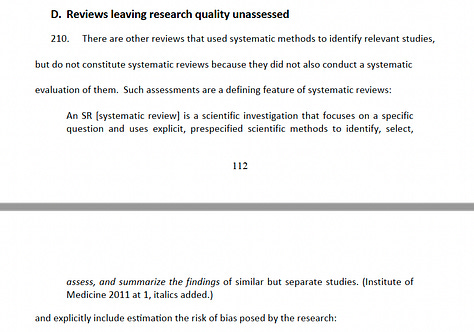
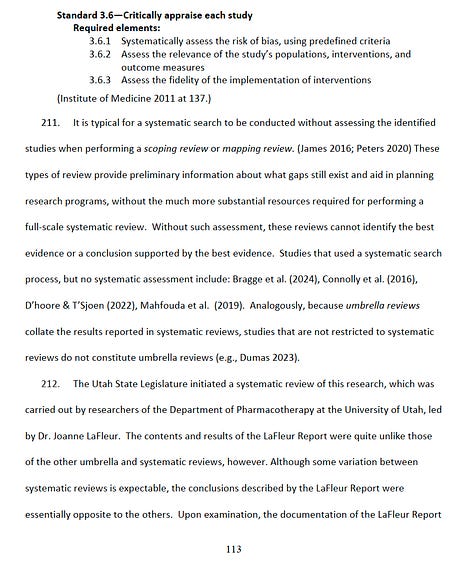
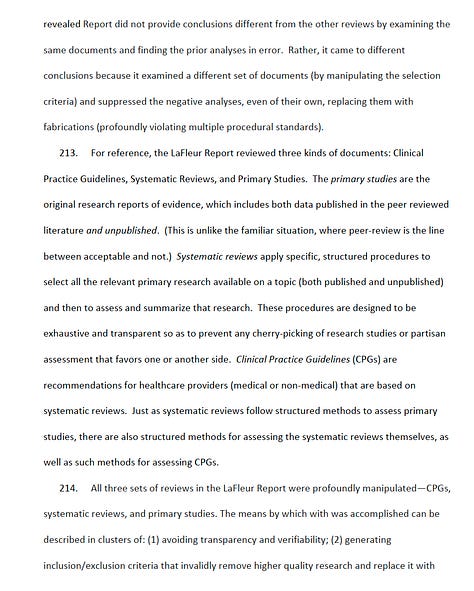
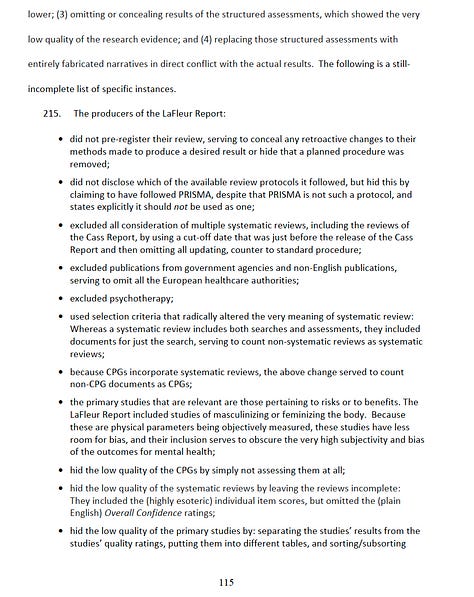
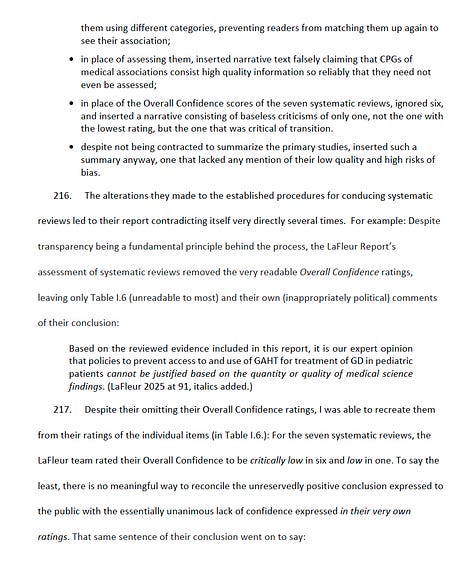
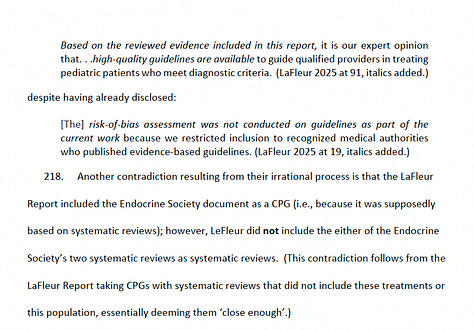
In particular, Dr. Cantor found the report:
• did not pre-register their review, serving to conceal any retroactive changes to their
methods made to produce a desired result or hide that a planned procedure was
removed;
• did not disclose which of the available review protocols it followed, but hid this by
claiming to have followed PRISMA, despite that PRISMA is not such a protocol, and
states explicitly it should not be used as one;
• excluded all consideration of multiple systematic reviews, including the reviews of
the Cass Report, by using a cut-off date that was just before the release of the Cass
Report and then omitting all updating, counter to standard procedure;
• excluded publications from government agencies and non-English publications,
serving to omit all the European healthcare authorities;
• excluded psychotherapy;
• used selection criteria that radically altered the very meaning of systematic review:
Whereas a systematic review includes both searches and assessments, they included
documents for just the search, serving to count non-systematic reviews as systematic
reviews;
• because CPGs incorporate systematic reviews, the above change served to count
non-CPG documents as CPGs;
• the primary studies that are relevant are those pertaining to risks or to benefits. The
LaFleur Report included studies of masculinizing or feminizing the body. Because
these are physical parameters being objectively measured, these studies have less
room for bias, and their inclusion serves to obscure the very high subjectivity and bias
of the outcomes for mental health;
• hid the low quality of the CPGs by simply not assessing them at all;
• hid the low quality of the systematic reviews by leaving the reviews incomplete:
They included the (highly esoteric) individual item scores, but omitted the (plain
English) Overall Confidence ratings;
• hid the low quality of the primary studies by: separating the studies’ results from the
studies’ quality ratings, putting them into different tables, and sorting/subsorting
116
them using different categories, preventing readers from matching them up again to
see their association;
• in place of assessing them, inserted narrative text falsely claiming that CPGs of
medical associations consist high quality information so reliably that they need not
even be assessed;
• in place of the Overall Confidence scores of the seven systematic reviews, ignored six,
and inserted a narrative consisting of baseless criticisms of only one, not the one with
the lowest rating, but the one that was critical of transition.
• despite not being contracted to summarize the primary studies, inserted such a
summary anyway, one that lacked any mention of their low quality and high risks of
bias.
I am an independent journalist, specializing in science and health care coverage. I contribute to The New York Times, The Guardian, NBC News and The New York Sun. I have also written for theWashington Post, The Atlantic and The Nation. Follow me on Twitter: @benryanwriter and Bluesky: @benryanwriter.bsky.social. Visit my website: benryan.net














Thank you for publishing the debate here....I had just finished reading it on Andrew's substack.
I am particularly interested in the question of whether, as it appears to me, "gender affirming care" is a sub rosa version of gay/lesbian conversion therapy, except worse.
In addition, Is "gender dysphoria" and "gender non-conformity" new ways of re-pathologizing homosexuality?
The argument over whether the Utah study was or wasn’t a systemic review feels very meta: if the authors *say* it was, and *believe* it was, then it was—no matter that systematic reviews have terms, requirements, etc. All that’s required is that the authors *believe* they have created a systematic review in order for it to *be* one.